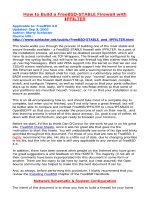How to Build a One-Year Operational Plan That Improves Performance
Bạn đang xem bản rút gọn của tài liệu. Xem và tải ngay bản đầy đủ của tài liệu tại đây (335.5 KB, 32 trang )
How to Build a One-Year
Operational Plan That
Improves Performance
I
n this chapter you move from the strategic view to the opera-
tional applications. Here you separate the strategic from the tac-
tical, the global from the specific, and the long term from the short
term. This is where most management energy is focused for execu-
tion.
The 1-Page Strategic Plan generally spells out where you intend
to take the organization while the operational plan defines how
you plan to make the trip. Yet getting to a practical application of a
211
CHAPTER
8
business plan seems to always get lost in the planning process.
Earlier you defined the goals, objectives, and tasks necessary to give
you three levels of definitions. Now let’s examine your business
plan up close by defining what must happen next year. This is
called the operational plan (see Figure 8-1). The content for the
plan is developed during the initial planning conference. All the
information for the operational plan can be extracted from the
original planning process. This is mostly true for the other plans as
well. The real task becomes putting the information into the right
portion of the 5-Page Business Plan. In lay language, we call this
“getting it in the right bucket.”
Seven Steps to a Successful Business Plan
212
Figure 8-1. The operational plan sets the direction into motion. It is how
you plan to work the next year.
The operational plan usually extends out one year (see Figure
8-2). It is always the first year of your strategic plan, which auto-
matically makes it the first year of your business plan. Although
some companies elect to use two or three years, one year is more
practical and best fits accepted business reporting standards. One
year fits with the quarterly concepts and the annual budget cycle.
This permits you to look at your performance on a frequent basis
and make annual adjustments if necessary. One year is also about
all the detail you can plan without becoming overwhelmed. Do not
spend a lot of time, if any, trying to develop the details and num-
bers for subsequent years because they will be adjusted as you work
with your plan over its life span.
How to Build a One-Year Operational Plan
213
Figure 8-2. The operational plan is cut out of the total ten years.
S
ITUATIONAL
A
NALYSIS
: T
HE
B
RIDGE
B
ETWEEN
THE
S
TRATEGIC
P
LAN AND THE
O
PERATIONAL
P
LAN
To get from the strategic view to the operational view you must do
very detailed thinking. Situational analysis is the middle or second
step of the backPlanning process (see Chapter 3), with strategic
thinking and operational execution being the first and third steps,
respectively. At this stage of planning you must do a reality check.
In strategic thinking you examined what you wanted to do in the
long term. Now you must carefully consider what can be done in
the short term in light of the realities of the business environment
in which you must act.
To conduct a good situational analysis, you must consider
eight criteria:
1. Analysis of company performance
a. Current
b. Historical
2. Analysis of competition
3. Analysis of market share
4. Analysis of mission
a. Implied tasks
b. Mission capability
5. Analysis of existing resources
6. Analysis of your business’s drivers—excluding, at this
time, your primary operational focus (i.e., single focus)
7. Analysis of existing structure
8. Analysis of reference information
a. Customer satisfaction survey
b. Employee satisfaction survey
c. Others as identified
Analysis of Company Performance
As part of the planning model you must conduct self-evaluations.
This means taking a hard look at your last year’s performance and
a second look at your overall performance from a historical view.
Usually there is no shortage of charts and graphs depicting how
well you did financially for the past year. The analysis usually
Seven Steps to a Successful Business Plan
214
includes one or more previous years, depending on the size print
and complexity of the chart. It always includes actual performance
against projected performance. Usually these are just numbers
drills.
To be truly effective you need to have some lessons learned.
You need to know why the numbers went up or down. Thought
must be given to why spikes occurred in your performance. A poor
showing cannot be written off as the result of a bad economy or an
unexpected downturn. These are simply excuses for mediocre man-
agement performance.
This analysis is where you start to sort out the serious planning
session from the weekend at the golf resort session. Often managers
are unprepared to talk specifics of the current business situation of
their industry at a planning session. This can only mean these peo-
ple came to the meeting unprepared. At your next planning session
have your principal attendees give a short briefing to the team on
the status of their portion of the business. This can be assigned as
homework in the preconference briefing.
The best team I’ve ever seen do this is Cedarglen Homes in
Calgary. The two principal players really know their business.
Robert Bezemer and Scott Haggins can talk for hours about the back
corners of the industry in Calgary, Alberta, and all of Canada. That
is because they are out every day dealing with the details of what it
takes to run a successful building company. This means they are
doing more than just building houses. Both executives are involved
and have a genuine interest in how their company fits into the
social fabric of the community. They spend a considerable amount
of time with customers, other builders, and the trades. This pays off
with a multiplier effect.
Analysis of Competition
Many planners want to start the initial planning process with a
SWOT (strengths, weaknesses, opportunities, and threats) analysis.
I disagree. While this is critical information to validate the plan-
ning content, it is the wrong starting point. To be creative and bold
How to Build a One-Year Operational Plan
215
in planning the team must start with the future and work back-
ward, so I advocate the backPlanning approach. This future orien-
tation removes the inherent limitations placed on the thinking
process. Once team members decide where they want to go, they
can test the validity of their decision with the situational analysis
to determine the plausibility and practicality of the plan.
If you are dead set on starting your planning process with a
competitive analysis flavor, think about these two points. First, the
more time you spend in competition the less time you have to
accomplish your own goals. Second, why do you care about the
competition, anyway? If you are accomplishing your goals, which
you freely set, why should you have more than a passing interest in
the competition? You need a healthy respect for your competitors
and should honor them as legitimate players in the market, but
don’t overdo it.
What I’ve observed is that competitive strategy actually should
be called competitive obsession. Management consultants have led
us astray in this area by building large, complex schemas for strate-
gic thinking and planning based on intricate formulas for compet-
itiveness. This approach appeals to the macho tendencies often
found in the upper levels of management. You don’t need a lot of
competitiveness except toward one thing—your vision and its asso-
ciated strategic goals.
Analysis of Market and Market Share
What is your market and who is your customer? Don’t tell me
everyone! Someone once asked Willie Sutton, the famous American
bank robber, why he robbed banks. His answer was very insightful.
“Because that’s where they keep the money.” A danger is to not
know where the money is kept. Are you guilty of selling or servic-
ing every customer with no real knowledge if it is a profitable sale
or not? When was the last time you did a careful screening of your
sales to decide which customers should be dropped?
Some companies think any sale is a good sale. That is simply
not so. You may be robbing a convenience store after-hours instead
Seven Steps to a Successful Business Plan
216
of a bank on payday. It’s hard to turn down an order when your
people are not busy or your machines are idle. The normal justifi-
cation for marginal to nonprofitable sales is to exercise the equip-
ment, keep the plant running, and pay for overhead. Well, that has
a downside, too. I’m not suggesting you turn down work or turn
away orders. What I am suggesting is that you look at work to see
if it is profitable.
Define your market and, specifically, who is and who is not
your customer. The latter is just as important as the former. When
EZCertify.com developed its business plan, the management
focused like a laser on this issue. After careful market analysis they
determined exactly who they were attempting to reach with their
product. By first defining the market and then the profile of the
actual customer within that market they were able to develop real-
istic annual targets. Without this information your operational
planning targets are going to be guesses at best and badly skewed.
Analysis of Mission
Give your mission statement another look during the planning
process. Make certain that you fully understand the implied tasks of
the mission statement. This gives you coordination points for activ-
ities that cross boundaries between staff functions. Ask these five
key questions as a validity check:
1. What am I being asked to do in the mission statement
that is not spelled out in the text?
2. Are there implications of those tasks that may or may
not be fully understood and appreciated?
3. What resources are going to be implicated when the
hidden tasks are brought to execution?
4. Have we coordinated those implied tasks among the
management team?
5. Are we fully committed to the range of tasks?
How to Build a One-Year Operational Plan
217
Another reason to revisit the mission statement is to confirm
your mission capability. That is defined as your ability to carry out
the requirements. In the plan that means you must be able to hit
the targets you are setting for the first year. Not only is mission
capability a planning issue, it has leadership implications as well.
Too often managers set targets, objectives, or goals that are beyond
the capabilities of the management team. Test your reality by ask-
ing several hard questions. Start with the following six about your
team and their ability to fulfill the mission:
1. Does my team have the management maturity to com-
plete the mission?
2. Do they have the wisdom, experience, and judgment to be
successful?
3. Are they willing to commit the time, energy, and effort to
accomplish the mission?
4. Can they complete the mission or operational tasks being
set within the time frames being established?
5. Are we giving the team the right tools and equipment to
get the job done?
6. Will they have enough information to properly do their
job in the spirit in which intended?
Analysis of Resources
You must review the resources requirement from two perspectives:
strategic and tactical. (Later, in Chapter 10, we look at the complete
resources plan by addressing strategic resources in more detail.)
For tactical or short-term existing resources supporting your
operational plan, you must be ruthlessly analytical. A great danger
of planning is to overcommit tasks and targets without adequate
resources for support. Consider these ten items when looking at
your existing resources base to support the operational plan:
Seven Steps to a Successful Business Plan
218
1. Time
a. Have we distributed the tasks over the right time
frame by quarter?
b. Is the time frame realistic for the task at hand?
2. Information
a. Do I have the right amount of information on hand
to make short-term decisions?
b. What additional data must I gather to support my
decisions?
c. How will I manage the volume of information
currently flowing through the system?
d. What are obstacles and barriers to overcome for
effective communication of information?
3. Staffing levels
a. Do I have the right amount of people in place to
accomplish the tasks?
b. Are the right skills represented among the workforce?
c. Will I be able to find and hire against my job skills
shortfall?
d. Can I afford to pay for the core competencies I need?
4. Facilities
a. Do we have adequate facilities to get the work done?
b. Are conditions in the offices, plants, or facilities
conducive to effective work?
5. Tools and equipment
a. Do we have the right items on hand to properly
do the job?
b. Can we afford any upgrades or replacements required?
c. How soon will we be able to get the tools and
equipment needed?
How to Build a One-Year Operational Plan
219
6. Technology
a. Will our existing technology be able to keep pace with
the action plan?
b. Can we afford to leapfrog technology?
c. What will be the implications of working with
outdated technology if our competitor is state-of-
the-art?
7. Relationships
a. Do we have the right partnerships, alliances, and
outsource partners for the mission?
b. How difficult will it be to put a relationship in place
to meet mission deadlines?
c. Are there old relationships that must be renegotiated
or dropped?
8. Intellectual capital
a. Do I have people with the willingness to share
experiences for a synergistic effect?
b. Do we have a formal database of lessons learned
to draw from along the way?
9. Financial
a. Do we have the money to support the annual plan?
b. Have budget considerations been included as an
internal part of the planning process or are they
an add-on feature?
10. Image
a. Will our brand recognition help or hinder us from
reaching the intended annual targets?
b. How must marketing be cranked up to support
the plan?
c. Are there customer or community activities that
need to be renewed or revisited?
Seven Steps to a Successful Business Plan
220
d. How can we make the most of our good name
and reputation?
Analysis of Drivers
In the planning conference you examined six key business drivers
and initially selected a single business driver as your focus. The sin-
gle focus creates alignment. Now you must account for the remain-
ing five drivers. You need to ask specific questions of your opera-
tions to make sure none of the other five have been neglected. Case
in point: Although Wal-Mart is not a customer-intimate business,
it certainly doesn’t mistreat the customer. Regardless of which driv-
er you select as your focus, you must maintain an acceptable level
of performance with the other five. Ask these questions for each
driver:
Players
1. Am I taking care of my employees? Does my plan
facilitate the employee component of our business, or is it
a punitive document?
2. Am I solving my customers’ problems? Have I looked at
what is at the center of my operational focus—customers
or things?
Plans
1. Are we operating in a planned way, or are we living from
day to day? Is the span of time for our plan long enough,
or have we been too limiting in time?
2. Are we disciplined about how we do business? Do we have
accountability measures in place to make sure the plan is
followed? Do the rewards and compensations match the
desired results of the plan?
Processes
1. Are we operationally efficient? Do we have a plan for con-
trolling overhead?
How to Build a One-Year Operational Plan
221
2. Do we pay attention to our business process? Are we
upgrading our ways of doing business or just continuing
to do business the same old way?
3. What is our level of heat loss? Do we know how much
money is draining out the bottom through inefficient
processes? What is our plan to fix the loss?
Products, Goods, and Services
1. Are we single-product focused with no alternatives? What
would be the implications of additional products? Have
we let go of obsolete but emotional lines of goods?
2. Where do we make our money? Is our attention and focus
in the right place?
Properties
1. Are we using our intellectual capital database as well as we
should? Is teamwork required of our people?
2. Are we protecting and preserving our capital assets? Are
we willing to invest money to make money with our facil-
ities and equipment?
Payoffs
1. Why should our customers buy from us? Have we made
the connection to our customers worth their effort?
2. Why should people work for us? Are we realistic about
what it costs to court and retain labor? Are we willing to
be top-of-the-line, or do we choose to be second string in
matters such as benefits? Can we afford it?
Analysis of Structure
To implement your operational plan you need the proper structure.
This topic has two halves and will be addressed in two places. The
big picture structural issues will be discussed in more detail in
Seven Steps to a Successful Business Plan
222









